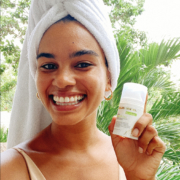ALL YOUR SKIN: What you need to know
Thankfully and at all, consumers are growing more aware of and curious about the effects of certain ingredients going onto and into our bodies. Sure, you likely press fresh OJ to boost your immunity during flu season. And yes, we do want certain ingredients—such as retinol, hyaluronic acid, and our other favorite actives—to penetrate the skin, or else we wouldn’t use them.
However, the unfortunate fact is that many unwanted aggressors find their way into our bodies via the skin. This journey can take place through environmental pollutants, a variety of lifestyle factors, and often through the products adorning our bathroom shelves.
Fast Facts on Skin and Body Care

The skin is your body’s largest organ, and special care must be taken to adequately protect it. Since different studies show that your skin can absorb up to 60% of the products you apply, it’s important to know which formulas promote both skin health and overall wellness. Even further, it’s essential to be fully aware of which ingredients you should avoid to prevent disturbances and adverse reactions.
According to a survey by the Environmental Working Group, people use an average of nine topical products daily containing 126 unique ingredients. A quarter of women use upward of 15 products, thus significantly increasing the chemical tally. Next, a 2003 study shows that risky substances can seep into your skin barrier and potentially lead to irritation, inflammation, sensitivities, and greater health risks such as hormonal disruptions and chronic illness. Simply put, even a basic skin and body care routine harness the potential to impact your health.
Skin and Absorption
 It’s challenging to definitively pin down exactly how much of specific products—and which products at that—can absorb into your bloodstream and thus pose potential risks.
It’s challenging to definitively pin down exactly how much of specific products—and which products at that—can absorb into your bloodstream and thus pose potential risks.
First, each body is different. Absorption levels will vary based on the health and integrity of your skin, which body parts (and their surface area) are exposed to application, and the length of time (daily and long-term) you used certain products.
Next, regarding products and ingredients, different factors come into play. In terms of formulation, the chemical size will be a key determinant. It’s more challenging for larger molecules to penetrate your skin’s protective layers, while smaller molecules have an easier time seeping through. Additionally, absorption will depend on the strength and amount of chemicals in a given product. You’ll know that a certain substance will be more potent if it’s high on the ingredient list (typically within the first five listings), or if the concentration percentage is above average.
How to Protect the Health of Your Skin and Body
The best way to prevent potentially (and proven) toxic ingredients from absorbing into your system is to be an active, educated consumer. To start, do research on the best and worst ingredients for skincare. However, you can’t take everything at face value; be sure to look to the sources and studies behind certain information. It’ll take time and effort, but your health and skin are well worth it.
Looking at the standards set by the EU is a great starting point. They’re much more stringent than the limits in place in the US; over 1,300 chemicals are banned across the pond, while the US has outlawed 11 and restricted not a great deal more.
In addition to avoiding disruptive culprits, swap them for clean skincare products backed by science and research. You can go beyond marketing claims by looking into a given brand’s story as well as its products’ ingredient list. The best skincare and bodycare brands will take care to educate their consumers not only on their offerings but healthy living at large.
At the end of the day, your strongest line of defense will be a healthy skin barrier, which you can maintain by using clean products that reduce inflammation, boost collagen, and replenish hydration and moisture levels.
Author Bio:
Michele Ross is a beauty and lifestyle writer based in Los Angeles. She’s passionate about clean skincare and hiking in the California sunshine (with adequate SPF, of course).
//
EWG on Skin Deep + stats
Cosmetic ingredients do not remain on the surface of the skin. They are designed to penetrate, and they do. Scientists have found many common cosmetic ingredients in human tissues, including phthalates in urine, preservatives called parabens in breast tumor tissue and persistent fragrance components in human fat. Do the concentrations at which they are typically found pose risks? For the most part, those studies have not been done. But a small but growing number of studies serve as scientific red flags (Swan 2005, Sathyanarayana 2008, Swan 2010).










Leave a Reply
Want to join the discussion?Feel free to contribute!